|
Deeper, faster, safer, cheaper—the demands on drilling rigs are huge, unrelenting and, sometimes, even contradictory. In an industry built over a hole in the ground, rigs are the technological standard-bearers in the process of turning prospects into assets. The following section—which is split into three main articles—highlights close to 20 of the latest innovations in rig technology, as well as the sum of those parts, as defined by offshore and onshore newbuild fleet additions.
RIG FLEET ADDITIONS–OFFSHORE NEWBUILDS
Adaptation carries the day
Deepwater drilling continues to be a major factor in rig construction and growth, as new drillships and semisubmersibles enter the market. But rig innovation is hardly confined to floaters. Recent additions to the global fleet also include jackups built for the Middle East heat and North Sea waves, as well as fast-moving, modular platform rigs built for nearly anywhere. Here are a few of the latest drilling units that help describe the scope of capabilities and technologies entering the offshore market.
Maersk Drilling has put a $2.6-billion deepwater investment afloat this year, with the delivery of four ultra-deepwater drillships, built by Samsung Heavy Industries. The first, Maersk Viking (Fig. 1), left the shipyard in February, followed by the Maersk Valliant and the Maersk Venturer. The fourth, Maersk Voyager, was due in fourth-quarter 2014.
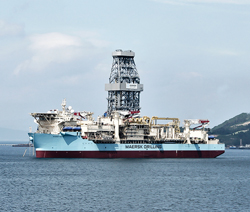 |
| Fig. 1. The Maersk Viking is one of four new ultra-deepwater drillships, representing a $2.6-billion investment, built by Samsung Heavy Industries and delivered this year to Maersk Drilling. Photo courtesy of Maersk Drilling. |
|
The new drillships are designed for efficiency, with dual derricks and large subsea work and storage areas, to support parallel and offline activities. The drillships are good for water depths of up to 12,000 ft and are capable of drilling wells to depths of more than 40,000 ft. Advanced positioning systems can automatically maintain a fixed position in severe weather conditions, with wave heights up to 11 m and wind speeds up to 26 m/s. Safety and consistency are promoted by the relatively small crew size and extensive automation.
One of the key features of the drilling package includes a multi-machine control system that conducts all standard operations, such as stand building and tripping, without personnel on the drill floor. Dual pipe-handling capabilities allow for the operation of a second string, independent of the one in the well, allowing casing, drill pipe or the BHA to be assembled, disassembled, and stored in the set-back area, to cut non-productive time (NPT). The traveling system—crown sheaves, traveling block and the main well center top drive—has a 1,250-t capacity, for a drilling depth of 40,000 ft. The circulation system has a dual-mud system for efficient changeovers between drilling and completion fluids. The rigs also have hands-free risers for safe handling of stand building, and dedicated, guided gantry cranes for BOP and subsea tree handling.
Maersk claimed the world’s largest jackup title, following the April delivery of the first of four ultra-harsh environment jackups. The Maersk Intrepid, built by Keppel FELS shipyard in Singapore, will be working in the North Sea. The fourth rig, due in 2016, will be built at the Daewoo Shipbuilding and Marine Engineering shipyard in South Korea.
The claim to the title of world’s largest jackup is based on a leg length of 678 ft, which allows the vessel to work in water as deep as 492 ft. The rigs have fully automated, dual pipe-handling capabilities, with the main drilling system comprised of National Oilwell Varco (NOV) components.
Diamond Offshore’s first two units of its four-rig, ultra-deepwater drillship order, the Ocean BlackHawk and the Ocean BlackHornet, commenced operations in the U.S. Gulf of Mexico during 2014.
The first newbuild drillship was ordered in first-quarter 2011, and, by January 2012, the company had four drillships on order. Diamond will take delivery of the Ocean BlackRhino in 2014 and the Ocean BlackLion in 2015. The four identical drillships, built by Hyundai Heavy Industries, represent a significant change in the company’s fleet balance. Previously, the fleet consisted of a single drillship, the Ocean Clipper, 30 semisubmersibles and seven jackups.
The four new drillships have a water depth capability of up to 12,000 ft, and a drilling depth capability all the way down to 40,000 ft. They are dynamically positioned vessels, with dual-activity capabilities, a maximum hookload capacity of 1,250 t, and two seven-ram BOPs. Drilling equipment includes an NOV derrick, drawworks, rotary, top drive and pipe handling equipment. Power is from six Himsen diesel engines rated at 4,500 kW, each driving 5,375-kVA AC generators.
In addition to the drillships, Diamond Offshore has added two deepwater semisubmersibles. The Ocean Apex was delivered this year at Jurong in Singapore. Meanwhile, the Ocean Onyx, which was delivered last year, was constructed at Keppel AmFELS shipyard in Brownsville, Texas.
The Ocean Apex has a maximum hookload capacity of 1,000 t, a 15,000-psi, five-ram BOP, a water depth capability of up to 6,000 ft, a drilling depth capability of 30,000 ft, a variable deckload of 7,000 long tons and crew quarters for 140 personnel. The unit has an NOV drilling equipment package, with power from five Caterpillar C17 Tier II diesel engines, rated at 2,400 hp, each, with 4,160-kVA AC generators
Gulf Drilling International Ltd. (GDI) in Qatar has received its fourth jackup in a five-rig contract with Keppel Offshore & Marine. The KFELS B Class jackups include this year’s Dukhan and the Les Hat, which was delivered last year. Construction of the fifth jackup, the Halul, has begun, with delivery set for first-quarter 2016. GDI has options for two more deliveries in 2017.
Customized to GDI’s requirements, the new jackup is designed to operate in the higher ambient temperature of the Middle East. The KFELS B Class is equipped with larger spud cans for reduced bearing pressure, and expand its operational coverage in more places, especially in seabeds, where soft soil is predominant. The rig can drill wells as deep as 30,000 ft, with a cantilever that can skid out 70 ft from the edge of the hull. It features offline stand-building capabilities and 7,500-psi mud pumps.
Keppel says that it has more than 10 of the KFELS B Class rigs operating in the Middle East. GDI has six land rigs and nine jackup rigs in operations, along with a jackup and lift boat.
Swissco Holdings Ltd. has purchased four additional, mobile offshore drilling units, bringing its fleet of rigs to eight. The rigs are being deployed to Latin America, where recently acquired contractor Scott and English Energy operates. The new rigs, which double the company’s fleet size, are in line with Swissco’s announced strategy of adding rigs for deployment in high-demand areas, such as Latin America.
In October, China Oilfield Services Ltd. began sea trials for its COSL Prospector, the fourth semisubmersible being built by CIMC Raffles. The semi can drill in water depths of 5,000 ft. It has a maximum drilling depth of 25,000 ft and a variable deck with a maximum load of 5,000 t. The rig is scheduled for delivery in late 2014. It will work in the Norwegian North Sea.
Archer has taken delivery of its second VDD-series modular rig from German builder Max Streicher, Fig. 2. The Archer Topaz will work in the Norwegian North Sea for Statoil, on the Heimdal field platform, to support a well abandonment campaign.
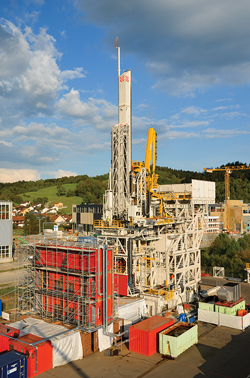 |
| Fig. 2. The Archer Topaz is the second VDD-series modular rig built by German firm Max Streicher for Archer’s work in the Norwegian North Sea, on behalf of Statoil. |
|
The Archer Emerald is the first in Streicher’s VDD class. It started work last year, drilling production wells from Shell Todd’s Maui A platform, offshore New Zealand. The Archer Topaz is the second iteration of the design. It is a super-single rack-and-pinion rig, in a lightweight, compact, modular package.
Designed for stand-alone operation, it can be rigged up rapidly, on the majority of offshore installations, to provide complete life-cycle drilling and workover services, from initial well delivery to decommissioning.
The hydraulically powered rig has a fully automated pipe handler; a pipe deck for storing rods and pipes; and a partially automated pipe-handling crane. The pipe handling system can deploy single Range 3 drill pipe, in maximum lengths of 14.5 m. It has a 400-t pull capability and a 190-rpm top drive. The rig has a maximum module weight of 12 t, for easy platform lifts. Rig-up time for the modular rig is about three weeks.
Blue Ocean Drilling Ltd. (BOD) will build two Gusto MSC CJ50 high-specification jackups, at Shanghai Waigaoqiao Shipbuilding in China, for delivery in first-quarter and third-quarter 2017. The rigs will be identical in design and equipped with NOV drilling, well control and mud systems, Fig. 3. They are also equipped with an enhanced power package that uses Caterpillar engines to deliver increased power of approximately 600 kW over the majority of today’s newbuild fleet designs, says BOD.
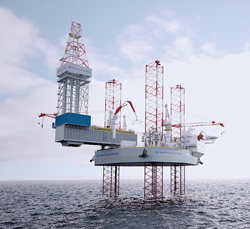 |
| Fig. 3. Two Gusto MSC CJ50 high-specification jackups will be built in China for Blue Ocean Drilling, for delivery during 2017. |
|
The jackups are designed to comply with the regulatory requirements in the UK North Sea. BOD has an option for the construction of two additional Gusto MSC CJ 50 rigs.
RIG FLEET ADDITIONS–ONSHORE NEWBUILDS
Shale turns rig innovation at high rpm’s
Land rig newbuilds are an impressive array of highly focused technology. Geared for efficiency in shale programs, they are intelligent rotaries—highly automated, wired for data acquisition, and plugged into satellite and internet communications networks. They move quickly across multi-well pads, and rig down to modular loads for fast transport and rig-up.
Nabors continues its newbuild program of PACE-X rigs (Fig. 4) for pad drilling in U.S. shale plays. In 2014, the company’s PACE-X newbuild program planned 20 units, at a build rate of approximately two rigs per month. In July, Nabors reported that they had 25 PACE-X rigs in the field, and planned eight additional X-rig deployments during 2014, all of which had contracts. Among the rig design attributes, says Nabors, are fewer permit loads, an omni-directional walking system, and a “side saddle” substructure that features 16-ft wide by 26-ft tall clearance. Nabors has 286 rigs in the U.S. Lower 48, and it operates approximately 500 working rigs in more than 25 countries.
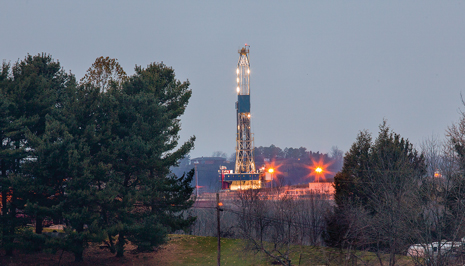 |
| Fig. 4. Nabors has pursued a furious pace of new PACE-X rig deployments during 2014, including PACE-X #07, shown here working for Chevron near Moundsville, WV, during November. |
|
Patterson-UTI Drilling had 137 APEX rigs, as of September 2014, and by mid-year 2015, the firm expects to have 158 APEX rigs. All that growth is in the APEX-XK 1500 model, which will increase from 29 to 50 rigs, up from approximately 19 units at the end of last year. APEX rigs are a fast-growing rig class in the fleet, increasing from roughly 30% in second-quarter 2010 to more than 60% in second-quarter 2014. All of the APEX rigs completed in 2014 will have walking systems for pad drilling operations. The APEX XK, in 1,500- and 1,000-hp ratings, is set up for moving efficiency. It has greater clearance under the floor, for the optional walking system, and advanced environmental spill control integrated into the drilling floor.
Unit Drilling completed its first BOSS rig in early 2014, and, in September, the company reported that six of the rigs were contracted. The BOSS (box on box self-stacking) rig is a proprietary design—a 1,500-hp, AC electric drilling rig built for multi-well pad drilling. Rig features include a multi-directional walking system, a compact location footprint and a quick assembly substructure that moves in 32 truckloads. The unit has two 2,200-hp mud pumps and dual-fuel-capable engines. Unit operates 118 onshore drilling rigs in the Anadarko and Arkoma basins, along the Rocky Mountains, and on the Texas and Louisiana Gulf Coast.
Helmerich and Payne (H&P) announced in June that it had agreements with five E&P companies to build and operate nine additional FlexRigs in the U.S., Fig. 5. The rigs are under multi-year, term contracts. The additions bring the total number of newbuild commitments announced in 2014 to 53 FlexRigs. The company has 328 land rigs in the U.S., 32 international land rigs and nine offshore platform rigs. H&P is scheduled to complete another 24 new FlexRigs under long-term contracts with customers. These rigs will bring H&P’s global fleet to about 384 land rigs, including 354 FlexRigs. The design is built in several models. The FlexRig 4 model introduced multi-well pad drilling capabilities to the rig line with 18,000-ft, 1,500-hp specs. The latest version, model 5, extends those capabilities to a 22,000-ft drilling capacity.
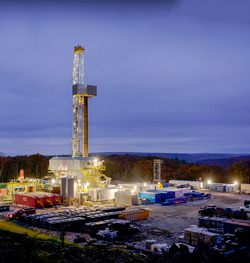 |
| Fig. 5. H&P’s popular FlexRig can now drill to 22,000 ft. |
|
Precision Drilling’s newbuilds revolve around their Super Series rig design (Fig. 6). The company plans to build 18 in 2014 and 16 in 2015, for a total of 238—113 in the U.S., 120 in Canada and five in international markets. Precision’s Super Series consists of three basic models—a 1500 and 1200 triple, and a single design. Built for high-performance horizontal drilling, the rigs’ features include walking/skidding systems, a small footprint and automated pipe handling.
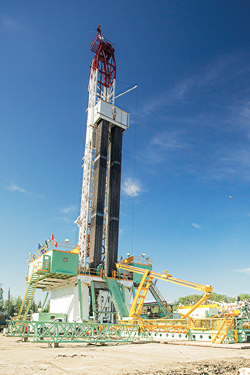 |
| Fig. 6. A Precision Drilling rig at work for Encana near Fox Creek, Alberta. |
|
Trinidad Drilling Ltd. in October announced that it would build five new rigs under long-term, take-or-pay contracts for its U.S. operations. The new units will be a high-performance Candrill design—1,500-hp, AC rigs with walking systems and 7,500-psi circulating systems. Built by Trinidad’s manufacturing division in Houston and Nisku, Alberta, the rigs are expected for delivery, to U.S. operators, during the first three quarters of 2015. The expected cost of the rigs is about $130 million.
In the Middle East, JV operations with Halliburton will add a fourth rig toward the end of 2014. In addition, the four newbuilds that are being constructed for the JV’s Mexican operations are under construction and expected to be delivered during late 2014/early 2015. Trinidad has 612 land rigs in Canada; 58 land rigs and five barge rigs in the U.S.; and four rigs in the Middle East.
Savanna Energy Services Corp. put its new VELOX drilling rig to work in the Permian basin of West Texas during latter-half 2014. The rig is a 1,500-hp, AC electric, highly mobile, triple drilling rig that extends Savanna’s design platform. The 750,000-lb rig features crane-less rig-up, automated pipe handling, moving systems and catwalks. Savanna newbuilds are focused on increasing the depth and capacity of its drilling fleet with deep, double and triple drilling rigs. The company is building 12 drilling and workover rigs for delivery this year, and in 2015. The building program includes three VELOX 1,500-hp, AC electric triples, and one 1,200-hp, AC electric double, as well as workover rigs for Australia.
RIG TECHNOLOGY ADVANCES
Hardware meets software on the rig floor
The old term, “dumb iron,” can hardly find a home anymore. Rig technologies increasingly encompass a wide swath of high-tech tools, from complete rig systems to innovations for management, automation and waste stream reduction. Following are some of the newest tools of the trade.
Rig regulatory compliance. Regulatory compliance has become a significant aspect of every rig’s operation. The response has been better ways of ensuring that safety and environmental objectives are met, wherever the rig is located. Life Cycle Engineering (LCE) is pursuing that goal with its development of critical asset performance standards (CAPS). These standards define key aspects of safety-critical elements, including equipment, procedures, personnel, inspections and verifications to reduce the risk of a catastrophic event, Fig. 7.
 |
| Fig. 7. Life Cycle Engineering is pursuing development of critical asset performance standards that define key aspects of safety-critical elements. |
|
Working with an offshore drilling contractor, LCE created a set of equipment-related performance standards that satisfy Australia’s National Offshore Petroleum Safety and Environmental Management Authority (NOPSEMA) regulations for offshore rigs. The contractor has an international fleet of drillships, semisubmersibles and jackups, and the resulting maintenance management system can be applied across the entire fleet, to inform current construction of high-specification rigs.
The process has two phases. The first is focused on identifying hazards, assessing risk and defining control measures. This involves an analysis of safety critical elements, by defining the rig’s potential safety-critical aspects. In the second phase, this information is used to develop performance standards that reflect rig design, local rules and regulations, and operational differences. Trending data and thresholds are then identified, and maintenance tasks are defined.
Maintenance tasks define risk mitigation or elimination of steps by focusing on how equipment is maintained and operated. This can include preventive maintenance, such as lubrication, inspections using non-destructive testing, installing a component using a precision installation procedure, or replacing a failed component.
Dome control. Petroleum-engineering students at Texas Tech University will begin well control classes with a high-tech, well-control training system installed in October at the Bob L. Herd Department of Petroleum Engineering. Using a 150° dome display, the learning platform presents academic and simulation training on the fundamentals of primary and secondary well control, for surface and subsea environments, Fig. 8.
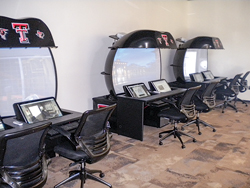 |
| Fig. 8. Petroleum-engineering students at Texas Tech University now have use of a high-tech, well-control training system installed at the Bob L. Herd Department of Petroleum Engineering. The installation is designed to produce high proficiency in well control operations by developing well control knowledge and skills. |
|
Developed by Check-6, the Well Control Competency Assurance Training installation is designed to produce high proficiency in well control operations by developing well control knowledge and skills. The system will be in the Chevron Well Control Simulation Lab at the new Terry Fuller Petroleum Engineering Building. The $22.8-million, 42,000-sq-ft facility was built to integrate formal teaching environments, with hands-on practical applications, using cutting-edge research facilities and techniques.
Green rig incubator. A rig technology group is conducting feasibility studies on candidate technologies to address air, water and land issues. The effort by the public and privately funded Environmentally Friendly Drilling (EFD) program, managed by the Houston Advanced Research Center, encompasses a broad swath of investigation, including tailgate emission research, to validate gas-fueled drilling technologies; evaluating onshore environmental benefits of dope-free pipe connections; advancing the use of longer-drilling aluminum drill pipe; and promoting lightweight U.S. Department of Transportation-certified drilling rigs to reduce roadway damage. The organization also has launched a virtual drilling rig site, and, more recently, a virtual hydraulic fracturing website. The site uses gaming software and graphics to familiarize users with best practices and increase public awareness.
Reducing the waste stream. Any discussion on minimizing rig waste leads pretty quickly to drilling fluids. Recently, that discussion has involved water-based fluids, which can be discharged onsite, or converted to road grading and other uses. M-I SWACO, a Schlumberger company, is developing onshore, synthetic-based drilling fluids, using readily biodegradable linear paraffin as the base fluid. It’s also involved with using nanotechnology in water-based mud to enhance wellbore stability and reduce the waste volume. Nanosilica-based products for water-based muds are also part of the mix—they physically, rather than chemically, block water intrusion into shales. The objective is better wellbore stability and less waste volume generated at the rig site.
Fluid recycling is another angle on waste minimization from M-I SWACO. Their RHE-USE solids-control technology relies on mechanical and chemical separation of ultra-fine low-gravity solids from invert emulsion drilling fluids, which allows reuse of oil-based drilling fluids over multiple wells, without the need for high rates of dilution.
Relieving the derrickman. Automation has been the centerpiece for improving rig safety and efficiency for decades. One of the latest advances for land rigs is a compact pipe handling system that removes personnel from the derrick, Fig. 9. Dubbed the stand transfer vehicle (STV) system, the NOV technology stages drill pipe and drill collars, by remote control, from the driller’s cabin. Lightweight and compact in design, NOV says the technology integrates with most double and triple masts and fingerboards, and is suitable for the majority of 1,000-to-3,000-hp land rigs. The STV uses a system of cameras and monitors for operator feedback, to provide intuitive operations and an easy training curve.
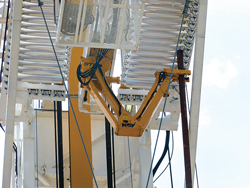 |
| Fig. 9. The STV compact pipe handling system from NOV removes personnel from the derrick, while staging drill pipe and drill collars, by remote control, from the driller’s cabin. |
|
The basic hardware consists of a primary arm that retains and releases the pipe, and a passive restraint fingerboard system to hold the pipe. A mechanical alignment system positions the STV at the finger slots. With foresight, the board has a pivot feature that moves it out of the way undamaged, if contacted by the top drive elevators.
Top hole driller. Efficiency in shale drilling operations is what one wakes up thinking about these days. A new hydraulic rig from Schramm gets the entire process off to a good start. The unit is designed for top-hole work, ahead of the big rig used for deeper and directional drilling. The trailer-mounted T250XD rotary was built specifically for shale operations, says Schramm, Fig. 10. The model is a Telemast series rig, which means it is a deeper drilling machine, with increased top drive travel, added BOP clearance, and an operator control room with satellite or Internet hookups.
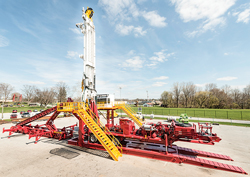 |
| Fig. 10. The trailer-mounted, hydraulic, T250XD rotary rig from Schramm gets shale off to a good start. The unit is designed for top-hole work, ahead of the big rig used for deeper and directional drilling. The company builds these rigs specifically for shale operations. |
|
The heavy hoist, deep-hole, top drive rig provides more than 10,000 ft of drilling capacity with a 250,000 lb hookload. It is equipped with Schramm’s LoadSafe XD automated, hands-free pipe handling system, and an automated drill floor, run with touch screen displays and joystick controllers. The rig also has interfaces for operator data acquisition and third-party performance monitoring devices.
In September, Keithville Well Drilling in Keithville, La., a contractor in the Haynesville shale, bought one of the first T250XD rigs. The new rig follows on last year’s debut of another Telemast rig—the T500XD unit, a walking rig with a 500,000-lb-rated hookload and 15,000-ft drilling depth. The first units went to work in the Marcellus and Utica shales.
Footprint reduction. The next generation Drillmec rig, due out in early 2015, is a fully automated, 1,600-hp, 750,000-lb static hookload unit, based on the company’s HH series hydraulic rig design. The Advanced Hydraulic Electrical Automated Driller (AHEAD) design reduces the rig’s footprint to about 50% of that of a comparable capacity rig, Fig. 11. The unit’s trailer-mounted components are designed to move quickly in 21 loads. A choice of slingshot type, or a hydraulic, self-leveling, elevating substructure, eliminates cranes to speed rig-up time. The hoisting system is based on a telescopic mast with tandem hydraulic pistons, and equipped with Drillmec’s integrated ETD series electric top drive. The company says the telescopic mast has environmental advantages over conventional derricks in its “reduced visual impact.”
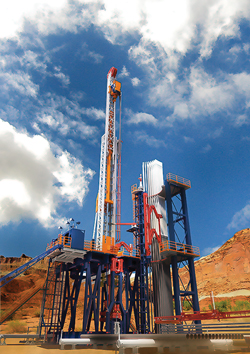 |
| Fig. 11. The next-generation Drillmec rig, due out in early 2015, is a fully automated, 1,600-hp, 750,000-lb static hookload unit, based on the HH series hydraulic rig design. The AHEAD design reduces the rig’s footprint to about 50% of that of a comparable capacity rig. |
|
The AHEAD rig is also equipped with a newly developed, fully automated off-line make-up system for speed and safety enhancement. The system makes up stands of two Range 3 DP (or three Range 2 DP) directly on mouse hole. The off-line system handles casing joints on special racks positioned at ground level. The system includes a vertical and horizontal pipe handler, and a modular vertical pipe rack, with a total capacity of 5,000 m of 5½-in. Range 3 DP.
Options include rig walking, data acquisition and drilling monitoring systems.
The series is set up for Drillmec’s Heart of Drilling (HoD) package. HoD combines a continuous circulation system, high-resolution flowrate monitoring and an anti-friction device. Continuous circulation of drilling fluid in the wellbore, combined with fine flowrate monitoring, is aimed at drilling wells characterized by very narrow pore/fracture pressure gradients, where interrupting circulation during drill pipe connections may lead to pressure-related events.
The anti-friction device, integrated into the continuous circulation subs or in the drill pipe tool joints, is used to reduce top drive and string stresses while drilling high-angle or horizontal sections of very long laterals.
MPD-ready risers. One of the biggest factors in the deepwater application of managed pressure drilling (MPD) is getting current rig systems to accommodate the technology, in time to meet the mobilization schedule. MPD technology, which depends on a closed-loop circulating system, instead of a conventional circulating system that is open to the atmosphere, is a proven tool in addressing many pressure-related deepwater drilling issues, from riser gas to narrow pore pressure/fracture gradient windows.
A key part of the implementation equation in an MPD-ready rig is the marine riser system. That’s getting focused attention from Weatherford, which a few years ago introduced the industry’s first marine MPD technology to integrate with the riser. Now the company has awarded a contract to 2H Offshore, an Acteon company, to design and deliver marine riser stacks for its next generation of integrated deepwater MPD. The 2H Offshore contract follows a feasibility study that produced multiple integrated concepts for the system. The system is specified to meet new regulations being adopted by DNV Drill Class N and the American Bureau of Shipping (ABS) CDS Certification.
Putting technology to the test. Ensuring field performance means testing—and preferably lots of it. That process will benefit from an engineering and testing alliance between specialty engineering company KnightHawk Engineering, and Mechanical Testing Services, an engineering, operational performance and equipment testing company.
The two Houston-based companies are providing engineered, custom, computer-controlled testing and monitoring for oil and gas equipment, including primary barriers, such as flanges, seals and seal assemblies, valves, chokes and check valves, and BOPs.
Dynamic shaker. A patent-pending shaker technology has been developed by Fluid Systems Inc. to increase solids control performance in drilling mud, waste management and fine screening systems. Its Prodigy shaker has two variable-speed motors in a configuration that creates linear or balanced elliptical motion at all points on the shaker basket. The design reportedly maximizes solids and liquid throughput, and reduces the fluid retention of cuttings, solids or screened material.
Automated catwalk. Mobile catwalks to remove crew from critical paths and pinch points are the latest addition to Tesco Corporation’s pipe handing capabilities. Brutus, Zeus and Hercules models were acquired from Custom Pipe Handlers Canada Inc. Adaptable to various rig structures, the catwalks offer solutions for pipe handling, from the ground to the rig floor. The technology is able to service multiple floor heights within minutes.
Standpipe instrumentation. A new standpipe gauge from HDI Instruments LLC ups the game for rig floor operations with a single-piece, self-contained configuration featuring a local display. The HDI 2000P mud/standpipe gauge system has the same electronic platform of the familiar HDI 2000B panel gauge, but it provides a single-piece construction, compared to the earlier model’s gauge head, connecting cable assembly, and a sensor housing package that, typically, mounts within a monitoring panel, Fig. 12.
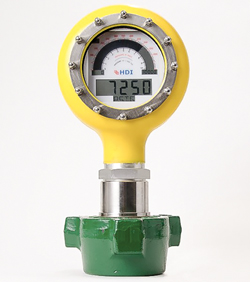 |
| Fig. 12. A new standpipe gauge from HDI Instruments LLC improves rig floor operations with a single-piece, self-contained configuration featuring a local display. |
|
The standpipe gauge operates independently and alongside HDI’s choke console, mud gas separator monitoring system, and valve position indicator system to monitor the rig’s manual gate valves. A “V” series option for these monitoring systems provides remote, virtual monitoring.
Multiport/Flowmeter. Well performance testing is necessary to update geologic models and optimize flow from multiple wells at a site. The conventional technique for doing this involves a complex manifold arrangement leading to a test separator—both with large footprints. A seven-well manifold would, typically, involve 21 isolation valves, in addition to all the piping.
However, according to Emerson, an alternative method is available that dramatically reduces the amount of hardware, weight, and space needed for this type of well testing. By using a multiport selector valve and a multiphase flow meter, operators can measure not only the average production but also the actual behavior of a well (e.g. slugging). Through this arrangement, automated well testing can be accomplished with a smaller footprint and much simpler design, Fig. 13.
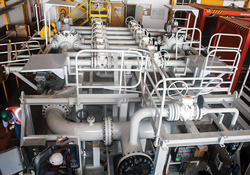 |
| Fig. 13. Emerson’s multiport selector skid on an offshore platform. |
|
Each of the seven wells can be routed into a single multiport selector that passes the flow from the well on test directly to the multiphase flow meter. Switching amongst the seven inputs can be automatically controlled by an RTU unit that activates a mechanical positioner. The multiphase flow meter provides information about the flow of each of the components typically produced i.e. oil, water, and gas. Additional measurement can be provided e.g. for the sand production from the well.
In a recent analysis of an offshore rig using the multiport/flowmeter technology as compared to the manifold/separator for a 6 in. manifold resulted in CAPEX savings of over $500,000, a footprint reduction of 15 sq m and a weight savings of 18 tons. Emerson expects these benefits will make the multiport/flowmeter combination the technology of choice especially for offshore installations and increasingly for onshore production wells.
Big lift top drive. A 1,500-t hoisting capacity distinguishes the most recent version of NOV’s TDX top drive. The drive adds hoisting capacity to a line-up that already includes 1,000 and 1,250-t models. Aimed at deepwater and high-pressure rigs, the TDX 1,500 has new features, including self-aligning gripper jaws, link tilt position feedback, and elevated hang-off loops that are 14 ft above the floor, at drill down, for safety, visibility and equipment clearance.
Trackless drill floors. A powered slew rotation and skid unit option adds rig floor layout options to NOV’s HydraTonog ARN-270 iron roughneck. The unit can rotate and extend between pipe targets, or skid to a park position to open up floor space. Stick-up height can be added, and there are options for use as a backup unit on drill floors with dual roughnecks. The unit features NOV’s latest torque Wrench design that allows 60° rotation for efficient make-up and breakout of singles and stands of drill pipe.
More underfoot. Digging timber out of the mud is a rig site chore. Dragon’s patent-pending ECOmat provides the foundation for a simpler process. An alternative to traditional wood and composite mats, this synthetic product has a solid core construction that resists liquids for mud and debris collection, which results in a lighter post-job weight that, in turn, reduces freight-out and cleaning costs. When clean, the mats each weigh about 2,750 lb. Recessed D rings make for easer loading, offloading, laying and moving. Dragon’s three-ply synthetic product is rated to 2,750 lb, and a four-ply digging mat is rated to 3,750 lb. The nail-less product is approved for overhead lifting, and it meets ASME B30 lifting standards.
Crown re-greasing eliminated. Eliminating re-greasing of the rig’s traveling block or crown block makes maintenance an easier and safer task. Timken Company’s Sheave Pac bearing assembly has a sealed sheave bearing assembly that allows it to run an entire operating cycle between rebuilds without the need for re-lubrication or additional maintenance. The pre-greased, pre-set and unitized Sheave Pac assembly easily interchanges with current industry-standard bearing assemblies and seals.
Stabilizing derrick safety. A casing stabilizer arm (CSA) developed by Aker Solutions eliminates the need for derrick personnel for tubular makeup, Fig. 14. Designed for both offshore and onshore rigs, the system stabilizing mechanism is stowed approximately 33 ft above the drilling floor, and it has a radio remote-control, internal hydraulic cylinder that extends and closes padded jaws.
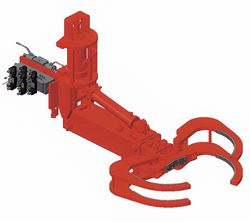 |
| Fig. 14. Developed by Aker Solutions, a casing stabilizer arm (CSA), designed for both offshore and onshore rigs, eliminates the need for derrick personnel to engage in tubular makeup. |
|
The CSA uses only three hydraulic cylinders to position and mobilize the pipe jaws—one each for lifting, extension and clamping. Safety features allow the device to interface with the rig’s anti-collision zone management system. The unit is rated for Class I, Division 1 locations and has double protection for dropped objects. A warning and alarm system is built into the CSA, along with an emergency shut-off control. Additionally, a shear pin is installed on the unit as a safeguard for an unexpected downward clash by hoisting equipment. The unit has tubular capacities of 27/8 to 22-in. diameter without changing jaws.
Going to gas. Changing from diesel to natural gas can cut rig fuels costs considerably. Continental Controls says that its Gas Substitution System (GSS) allows the switchover, without modifying the engine, and without loss of horsepower or performance. Based on fuel-control technology, the system interfaces directly with the engine control unit. Fuel substitution is controlled using a variable pressure valve to supply the maximum amount of diesel at almost any load condition for any application. The GSS has a compact fuel train, with a low profile that fits easily on almost any engine skid. 
|
















